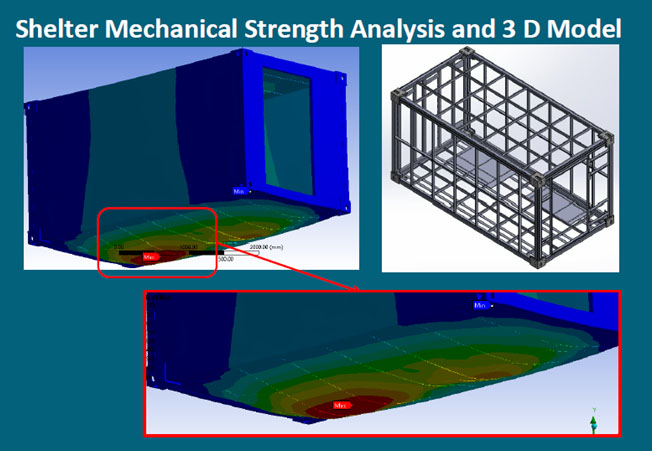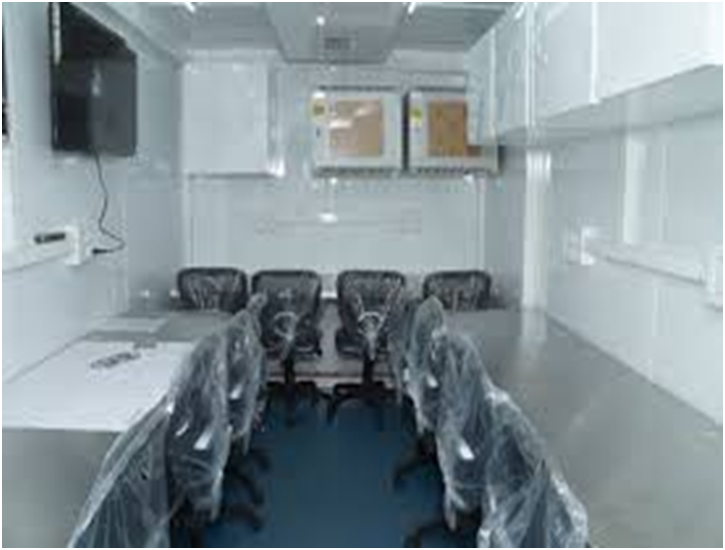Services

Services- Engineering Capabilities
Chanakya Engineering staff includes experienced design engineers. Chanakya design process places an highlighting upon solid, three-dimensional computerized modeling in order to ensure fit and function prior to engineering release. Chanakya uses Solid Works 3D design and structural analysis to develop and validate both static and dynamic loads to a complex finite element model. The analytical data is the interpreted by Chanaka engineers, enabling them to predict equipment shock and vibration response, determine structural integrity, and to verify proper system weight distribution. This thorough design approach ensures that a successful system design is accomplished the first time, eliminating costly redesign and expensive testing.
Design and Documentation capabilities:
Project Management
Chanakya will provide a detailed project schedule consistent with the contract major milestone schedule. The schedule, at a minimum, will delineate the time phase for design analysis documentation, procurement, assembly, test packing and shipment for all contracted equipment. The schedule will be detailed to a sufficient level to provide visibility of the manufacturing critical path(s). Chanakya prepare the project detailed schedule using MS project software (GANTT Chart/NETWORK DIAGRAM).
Program Stages
The program shall consist of the following stages:


System Integration
Chanakya can provide system and subsystem integration for all the electrical/electronic/network components and can offer with turn-key projects designed for a variety of applications.
Design, supply and installation from MIL-STD 19" racks, Special design racks for dedicated equipment, Power supply and distribution racks, I/O panels, Vibration and shock monitoring, RFI shielding and filters, Surge arrestors and lightning protection, Power supplies and distribution systems, Electrical panels, Illumination, smoke & heat detection system, MIL-STD cables and connectors to complex computer systems, providing customers with unique solutions that meet specific requirements.
Chanakyahas the integration experience necessary to provide complete system solutions.
Field Service, Annual maintainenance and Refurbishment capabilities
Chanakya Shelter Technologies Pvt.Ltd. has experience in providing field support for shelter repair and maintenance as well as shelter subsystems including cable assemblies, rack assemblies, power distribution board, Antenna Integration, power supply subsystems, HVAC subsystems, and operator workstations.
Government Agencies
Private Sector Companies
Export Sector
In this endeavor we shall:
Quality Assurance
General
Chanakya implemented and maintains an effective quality assurance system in accordance with ISO 9001:2015.
The range of the quality inspection tests needed to confirm the technical specification, characteristics and performance of the shelters. Quality inspection tests will be performed in two types:
Acceptance tests: will be conducted in order to confirm that the Shelters can withstand all functional requirements specified in this document.
Qualification test: will be conducted in order to confirm that the Shelters can withstand the environmental/functional conditions specified in this document.
Responsibility
General Responsibility
Responsibility for test equipment
Chanakya responsible to provide all standard test equipment needed to perform the quality assurance test. Chanakya responsible for testing and calibrating the test equipment.Responsibility for test results and documents.Chanakya responsible to maintain and provide a test results and Documentation files on the Quality assurance test.
Acceptance Test Procedure
This document will be provided in advance and will get an approval prior testing. This document will be generated based on the product requirements
Qualification Tests
Chanakya perform qualification tests, the qualification test plan for the system shelters. The tests will verify that the shelter withstands the conditions specified. The qualification tests will be in ASTM E 1925-01 and MIL-S-55826E:
C.O.C
Each shelter configuration and accessories will be delivered together with a Certification of Compliance (C.O.C) to the requirements specified herein. Purchased Equipment will be accompanied by an applicable C.O.C and Test Certificate
Preparations for deliveries
The completed shelter unit will be prepared for delivery the requirements stipulated in the contract. All loose items will be securely stowed inside the shelter. All openings will be protected to prevent infiltration of dirt during transport
Marking & Painting
Shelter transportation instruction plate
The shelter will have a transportation instruction plate including:
Identification
The shelter will have a name plate including the following information:
The name plate will be printed in black on an aluminum plate and riveted to the shelter near the entrance door.
The Name Plate will be in English
External Marking
The shelter will have painted marking on the external shelter walls:
All connectors on I/O panels will be marked accordingly.
Marking will be in English.
Internal Marking
Following items to be marked with black print on aluminum plates:
The emergency exit will also be marked with a glowing exit sign.
All the markings above will be in English.
Shelter painting
The painted shelter will meet the requirements of the shelter specification and will withstand all the environmental requirements. High solid PU paint will be used. RAL Shade will be taken into reference while selecting the color
Packaging
All major units and parts of the supplier will be preserved, packaged and packed in according with accepted commercial so as to provide adequate protection against deterioration and damage during shipment, handling and storage.
Workmanship
Workmanship will be in accordance with guideline 9 of MIL-HDBK-454A. Workmanship will be subject to inspection and quality approval of the corresponding inspection activity. All stages of manufacture and assembly will be carefully controlled by contractor's process specification and standard to ensure that the design, quality, safety and reliability requirement are achieved. The workmanship displayed in fabrication and assembly will ensure the ability of all equipment to meet the requirements specified herein and in detail specifications under all specified conditions. The quality of workmanship will not adversely affect safety, function, performance, serviceability, interchangeability and appearance.
Interchangeability
Interchangeability requirements will be in accordance with guideline 7 of MIL-HDBK-454, Identical and interchangeable parts and assemblies will be used wherever possible. The LRU's respectively of same type will be designed so that they are interchangeable. Alignment and adjustment requirement will be minimized. LRU's design and construction will incorporate features that mechanically and electronically prevent incorrect installation of the equipment or improve attachment of electrical plugs and other such items. Like units, assemblies and replaceable parts will be physically and functionally interchangeable without modification of such items or of the equipment. Individual items will not be hand-picked for fit or performance. Identification marking except serial numbers where applicable will be identical to delivery- configuration part identification marking.
Configuration Management
Configuration management will meet MIL-STD-973 requirements
Configuration Management Plan (CMP) for the project
Chanakya will submit its project-specific Configuration Management Plan (CMP) to Prime Contractor approval.
The CMP will refer to project configuration management and will cover the following topics:
